The Definitive Sennheiser E965 Review
Total flexibility for pro sounding live vocals
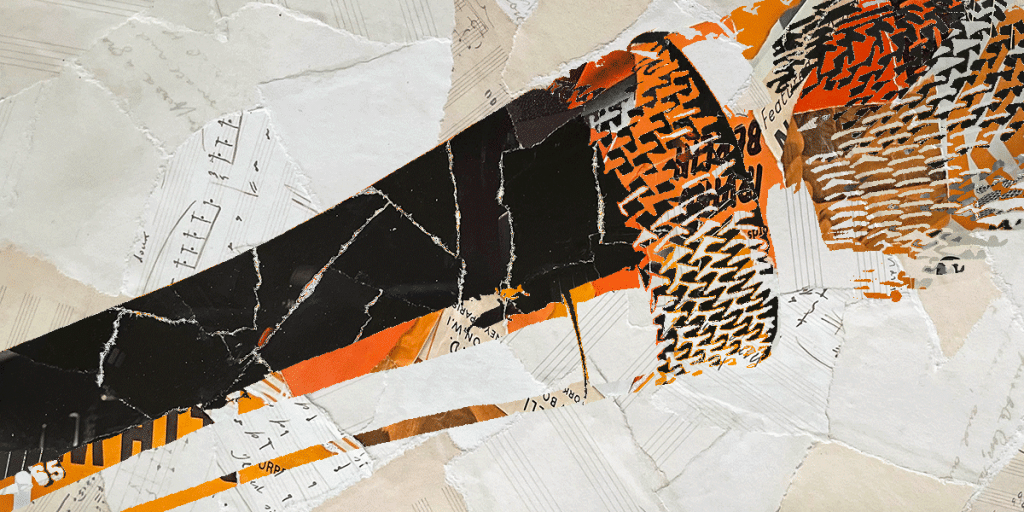
Reviewed by: Paul Narang
Review date: November 2022
Current price: Under $400
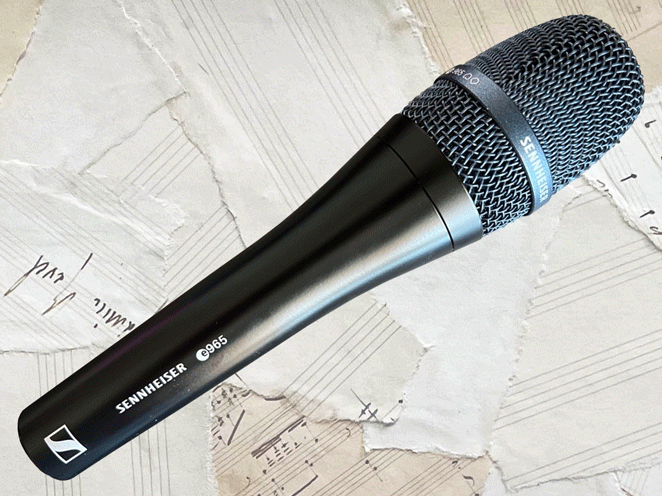

Sennheiser E965 Review
| Pros: | Cons: |
| Rugged Construction Wide frequency response Switchable Polar Pattern Attenuation Switch | Heavier than similar mics |
Sennheiser E965 Review
The Sennheiser E965 is a live vocal condenser mic with a switchable polar pattern. Set it to cardioid or super cardioid, depending on your specific requirements. It’s a robust, metal-bodied mic, with a full and detailed sound.
The E965 is a sensitive mic with a hard exterior, designed to meet every requirement of live stage use.
What is it?
Sennheiser are undoubtably one of the leading brands when it comes to microphones. And it’s not just vocal mics – they have a global professional user base across broadcasting, live music and recording studios.
The E965 model is from Sennheiser’s high-end Evolution 900 series, designed to serve vocalists and musicians for live music. The Evolution series collection includes:
- Sennheiser E935 cardioid dynamic (reviewed here)
- Sennheiser E945 supercardioid dynamic (reviewed here)
- Sennheiser E965 condenser with switchable polar pattern
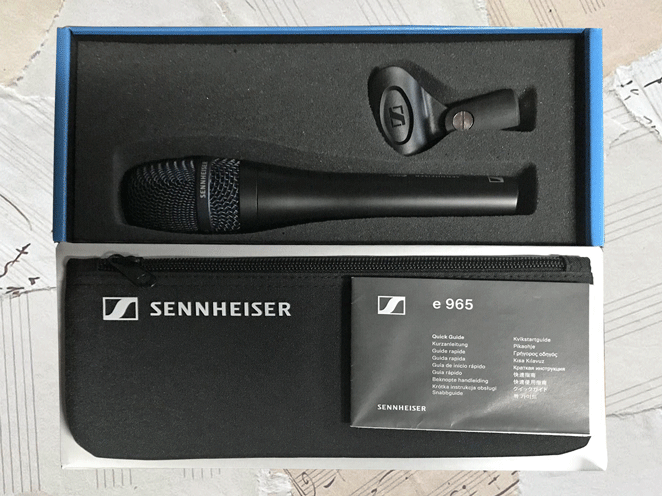
In the box
The Sennheiser E965 vocal mic arrived in a smart blue, black and grey cardboard box which also included a:
- Microphone clamp
- Zip up microphone pouch
- User manual
Dynamic vs condenser microphones
The Sennheiser E965 is a ‘condenser’ mic which has been designed specifically for use on stage. Condenser mics aren’t always the obvious choice for live use, because they’re more delicate than dynamic mics, like the Shure SM58.
Condenser microphones differ from dynamics in the following ways:
- They tend to be less rugged
- They have a wider frequency response
- They have a more detailed sound
- They require phantom power
- They’re more expensive
Condenser microphones for stage use
So why use a condenser on stage? Because condensers offer a brighter, more detailed sound, and will give any vocalist that air and sparkle normally only available in the recording studio.
Many singers and softer styles of music will benefit from the extra detail and clarity of a condenser. Singers with quieter voices will find that a live condenser mic can better convey the emotion and intimacy of their performances.
But as condensers are more sensitive than dynamic mics, they might not be the best choice for everyone. Loud rock or metal bands will probably prefer the resilience of a robust dynamic mic.
Condenser mics designed for the rigours of live use have internal shock mounts, which protect the diaphragm and capsule from damage, and reduce handling noise and stage vibrations.
Sennheiser E965 Dual Polar patterns
The E965 can switch between two different polar patterns: cardioid and super-cardioid. This is like having two mics in one, and is a real bonus.
A cardioid polar pattern picks up sound in a heart shape around the front of the microphone. It’s most sensitive ‘on-axis’ (at 0 degrees), but also picks up sound around 65 degrees either side of the mic. A cardioid polar pattern shouldn’t pick up any sound from the rear of the microphone.
A supercardioid pattern is a little tighter around the mic, picking up sound around 57 degrees each side of the mic. However, there is a small amount of sensitivity at the rear of the mic (called a rear lobe).
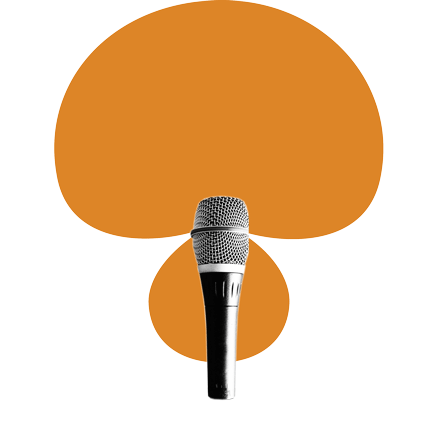
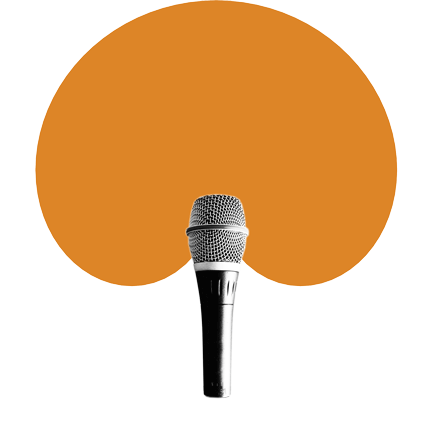
On stage, the wider cardioid pattern is more suited to singers who move around the mic a bit more. It can also be a bit more forgiving when it comes to microphone technique.
But for noisy stage environments, a supercardioid pattern does a better job of rejecting noise from monitors and other instruments.
In the studio, a cardioid mic is probably all you need in a well-isolated vocal booth. But a supercardioid pattern would be better when recording a full band in a single room.
Some sound engineers also favour the increased directionality of a supercardioid when recording drums or other instruments.
No on/off switch on the Sennheiser E965?
There’s no on/off switch on the E965 or any of the latest Sennheiser Evolution 900 series vocal mics.
Pro-level mics often don’t have on/off switches, because it make it less likely that the singer will accidentally turn off the mic mid performance. The sound engineer will normally mute the mic from the mixing desk when needed.
If you particularly need an on/off switch, take a look at the earlier Evolution 800 series, which include the cardioid pattern E835 S (review here), and the super cardioid E845 S (review here). Both of these models are available with a switch
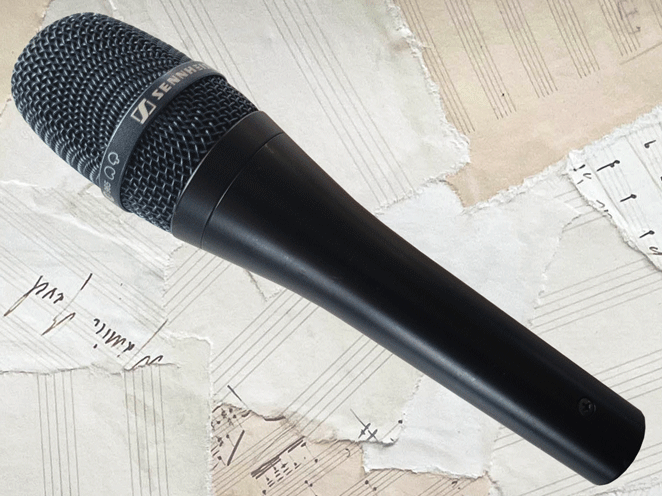
Phantom power for the Sennheiser E965?
As a condenser mic, the Sennheiser E965 does require phantom power. Phantom power is a small, low voltage current, which is sent to the microphone from either a:
- microphone preamp
- mixing desk
- audio interface
- Stand alone unit
Most industry standard desks or interfaces are capable of providing phantom power, which is sent through the XLR cable to the microphone.
If your audio interface or mixer doesn’t provide phantom power, you can connect the mic to an external 48 volt phantom supply. Then simply connect the output of the phantom supply unit to your desk or amplification.
Connecting the Sennheiser E965
The E965 uses an XLR cable to connect directly to the audio interface or mixer. XLR are the standard connectors on all professional studio equipment. They’re ‘balanced’, which means the cables are shielded from interference and carry a higher signal than unbalanced cables.
XLR cables are the only cables capable of carrying phantom power to the mic.
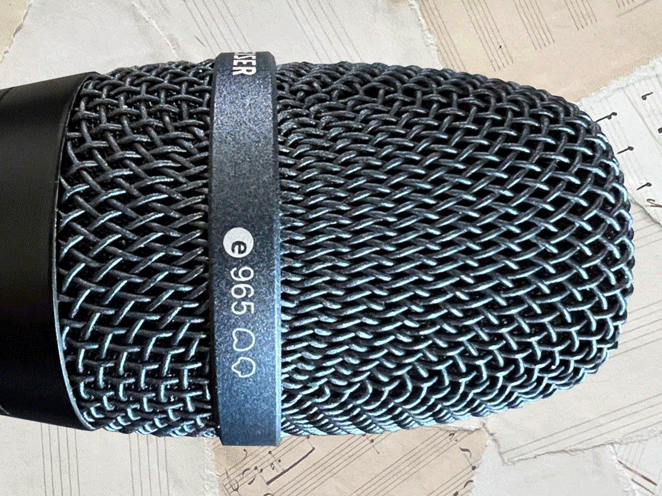
The Sennheiser E965 Design and Build
The E965 looks slick in its all-black metal casing with matching black grille. The grille screws off to reveal 3 switches, where you can apply:
- low-cut
- 10 dB attenuation
- change the polar pattern
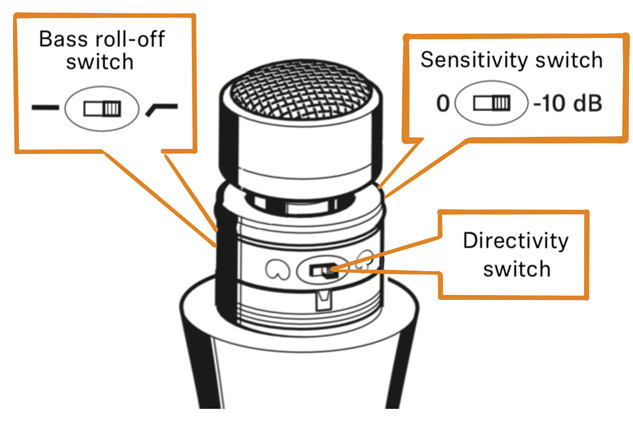
Having the switches tucked safely behind the grille is a great feature – there’s no chance of accidentally switching things up mid-performance.
At 396 grams, the E965 is heavier than many other hand-held vocal mics. But for me, the extra weight gives it a feel of quality.
It’s no secret that musicians and sound engineers normally reach for dynamic mics to amplify a live stage. Why? Because they’re the safe bet – virtually guaranteed to stand up to the abuse and beating of live use and life on the road.
But With the E965, Sennheiser have successfully incorporated some of the best features of a dynamic mic into their stage condenser. It’s a solid, rugged mic, with a shock-mount built into the diaphragm. This equates to low handling noise, but still with the benefit of an ultra-wide frequency response.
Sennheiser E965 Dimensions and Weight
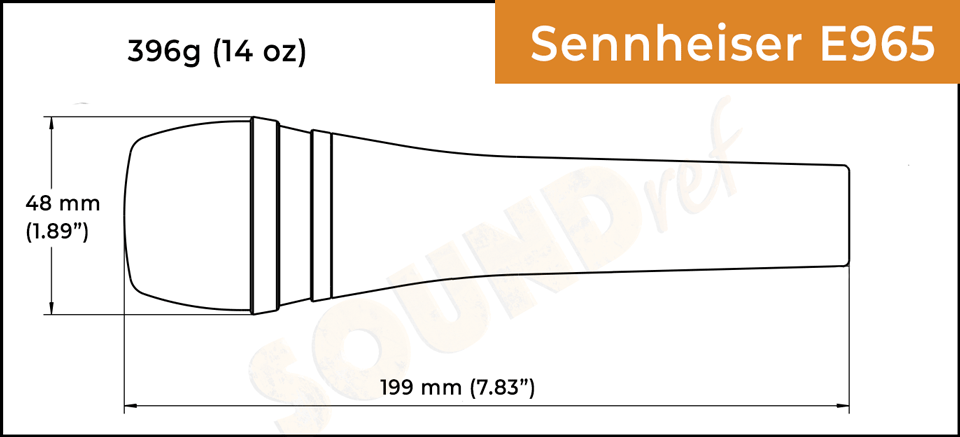
The head of the E965 is 48 mm (1.89”) and it weighs in at 396g (14oz) – slightly heavy for a stage mic, but not quite as heavy as the Telefunken M80 which weighs in at 430g (review here).
At a length of 199 mm (7.83”), it’s slightly longer than the Shure SM58. The mic feels solid and sturdy in hand – you get a sense you’re holding something well built.
Sennheiser E965 Frequency response
On of the benefits of the E965 is that is has a much wider frequency response than comparable live dynamic vocal mics.
A nice flat response from 100hz right up to 5khz means you’ll get a true reproduction of your voice throughout the mid-range. Why is this important? Because it’s the area where the warmth and richness of your individual sound comes from.
Moving up from 5khz you’ll get a lift in the frequencies, imparting a silky smooth presence to your vocal delivery. This really helps with the clarity of the voice as it cuts through the rest of the band.
The consonants of your words will come through clearly, and your sound engineer will have plenty of strong signal to craft that perfect vocal sound.
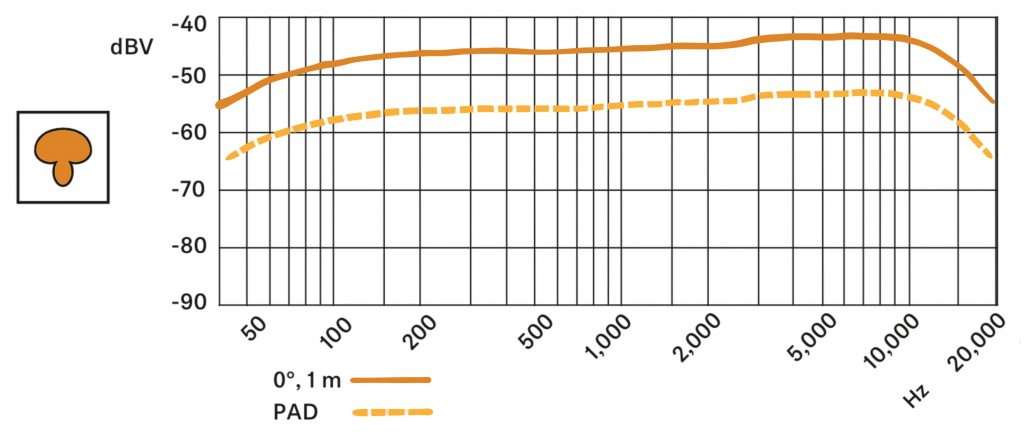
In Cardioid mode, you’ll get a little more presence at around 10khz for that desirable “air” or “breathiness” in your sound.
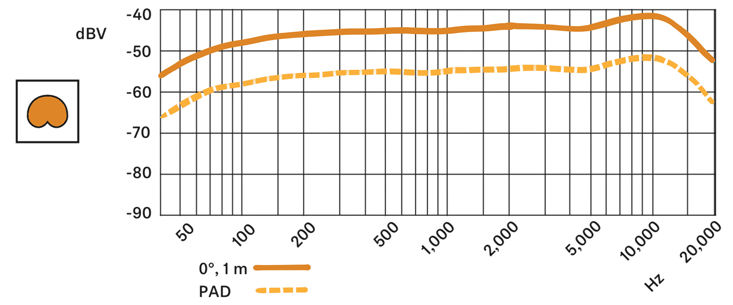
Many studio level condensers have a fairly flat response from 20Hz, right up to 20Khz. But in practice, this isn’t really needed for a live vocal mic. The dip in the frequency response below 40Hz helps to reduce any rumbles from the mic being held, or the stand being knocked.
It also has a ‘low cut’ switch which removes even more of the low end, making the sound engineers’ job much easier when trying to achieve a clean mix free of bass frequency clutter.
Sennheiser E965 Impedance
As expected, Sennheiser designed the E965 with low impedance. A nominal impedance of 50 Ohms, means you can plug it in using very long cables without loosing any sound quality.
This is perfect for a stage microphone, as the mixing desk is often some distance away from the stage at the back of the venue.
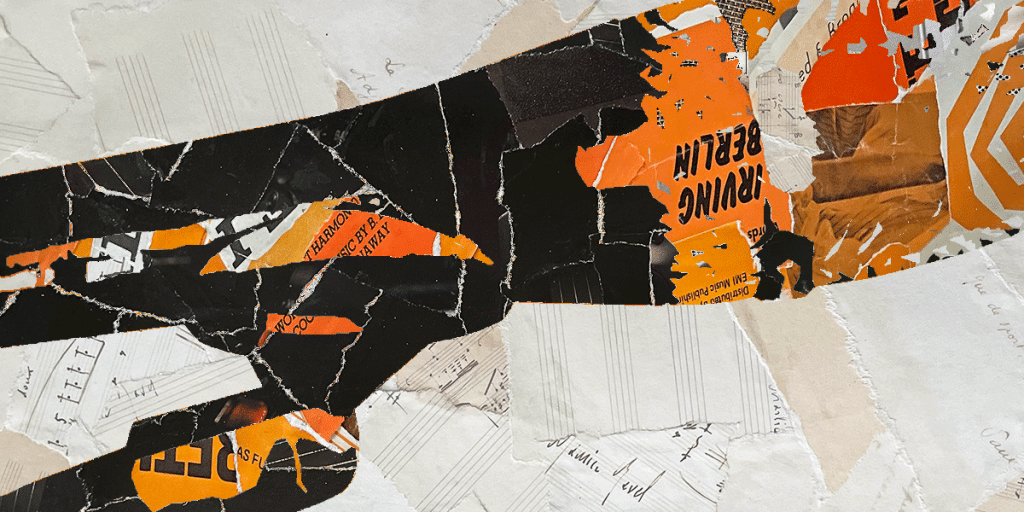
Sennheiser E965 Sound quality
If you’re looking for live vocals with the level of clarity and refinement you normally achieve in the studio, the E965 should definitely be worthy of your consideration.
The full-range frequency response will give you more than just a faithful reproduction of your voice. The condenser capsule delivers that ‘larger than life’ sound, with some lovely detail in the mid range.
It’s a beautifully balanced and nuanced mic, with a naturally bright and open sound.
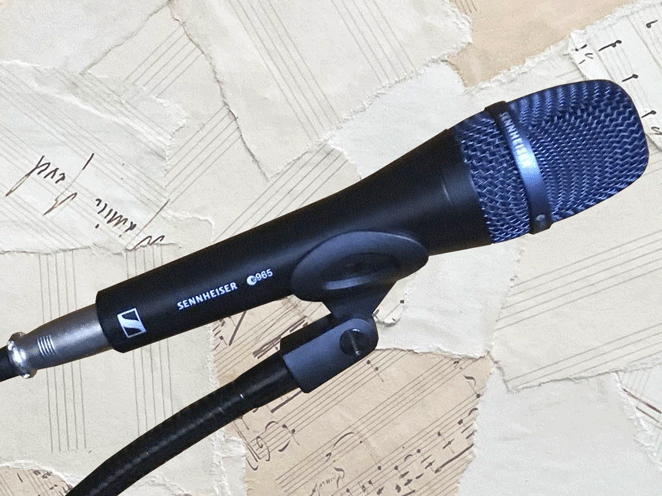
Sennheiser E965 in live performance
For a live vocal mic to have a switchable polar patten, and an attenuation pad switch to alter its sensitivity, is something rather special.
It makes the E965 flexible for a variety of different situations and styles of vocalist. You’ll be able to use the E965 for anything from the quietest of voices, through to screaming rock vocals.
Turning on the pad switch removes 10 decibels from the mic’s output and makes the E965 behave more like a dynamic when you need it to. It’s got a massive SPL (Sound Pressure Level) of 152 db with the attenuation switch activated.
For context, that’s the volume level of a firing gun!
An internal acoustic pop shield is a desirable feature for any live vocal microphone, and it’s good to see that Sennheiser have designed one into the E965 to reduce any distracting plosives.
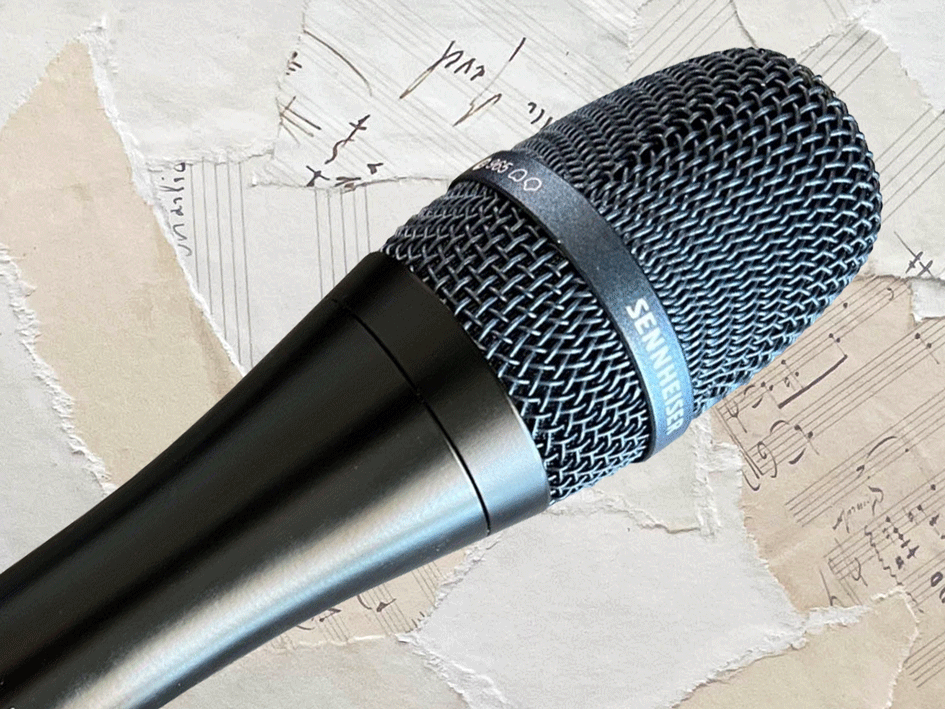
The Sennheiser E965 in the home studio
As it’s a large diaphragm condenser mic, the E965 is also a great addition for your home recording studio.
A good quality condenser such as the Sennheiser E965 can be used in many recording scenarios, in the studio or on location, where the low cut switch can reduce wind noise.
Because this wide frequency condenser microphone captures rich harmonics with clarity, you’ll have more to play with when it comes to mixing. You’ll be able to bring out the natural overtones and character of whatever you’re recording – instruments or vocals.
Sennheiser E965 vs Shure SM86
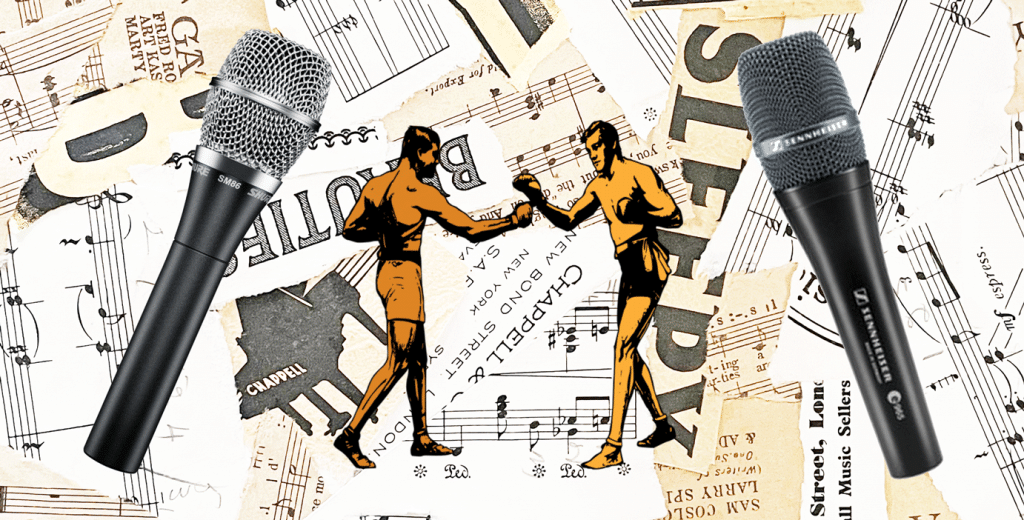
The Shure SM86 is another rugged condenser mic, designed for live use and touring. It features a 3 point shock mount to minimise handling noise and an internal pop filter. It’s actually the cardioid version of the (supercardioid) Shure SM87A, which is now discontinued.
| Sennhesier E965 | Shure SM86 | |
| Polar pattern | Cardioid & super cardioid | Cardioid |
| Frequency | 40Hz to 20KHz | 50Hz to 18kHz |
| Attenuation | Attenuation Switch (-10db) | No attenuation switch |
| Pop filter | Integrated | Integrated |
| Weight | 396 grams (14 oz) | 284 grams (10 oz) |
| Target price | Under $400 | Under $200 |
The obvious attraction of the Shure SM86 is the price – its around half the cost of the E965. Plus it’s lighter, which might be a consideration if you don’t like handling too much weight on stage.
As an investment though, the E965 offers a lot more flexibility for different situations. You’ll get a better overall sound, both on stage and in your recordings.
In a home recording studio, the E965’s wider frequency response means rich detailed sound. And the changeable polar patterns means you can tailor the response of the mic to your recording environment, bringing in more or less of the sound of the room.
Sennheiser E965 vs Neumann KMS104
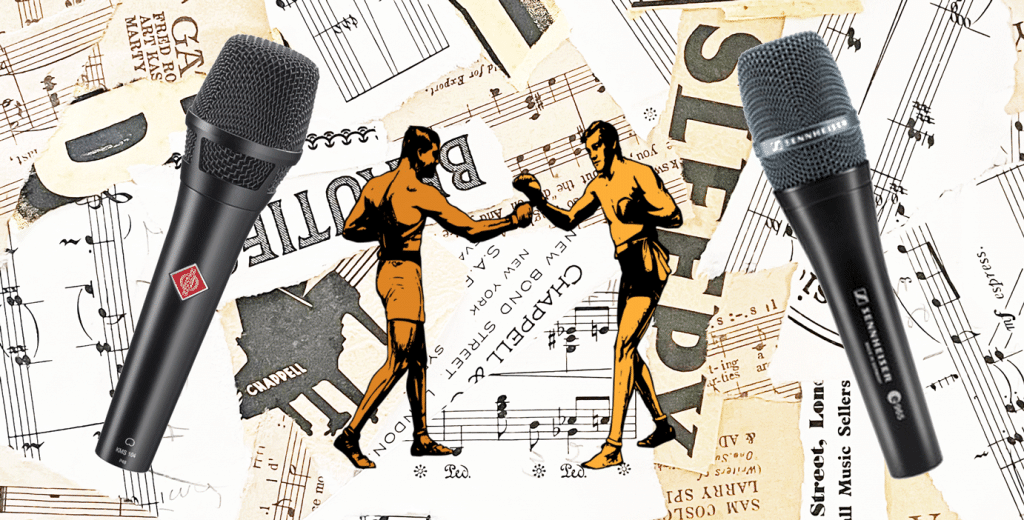
Neumann are one of the most well respected microphone manufacturers in the music industry. They also make great condenser microphones designed for live performance, like the KMS 104.
| Sennheiser E965 | Neumann KMS 104 | |
| Polar pattern | Cardioid or Super cardioid | Cardioid |
| Frequency | 40Hz to 20KHz | 20Hz to 20KHz |
| Attenuation | Attenuation Switch (-10db) | No attenuation switch |
| Pop filter | Integrated | Integrated |
| Weight | 396 grams | 300 grams |
| Target price | Under $400 | Under $550 |
Neumann’s build quality and sound reproduction on both the KMS 104 and the KMS 105 (the supercardioid version) is truly excellent. There’s no doubt the KMS Mic series will give you serious studio quality sound on stage.
It’s a close call between Neumann and Sennheiser here, with both offering the benefits of condenser capsules with excellent frequency response and sensitivity. However, the E965’s flexibility of features and its price point wins it for me.
Shure KSM9 vs Sennheiser E965
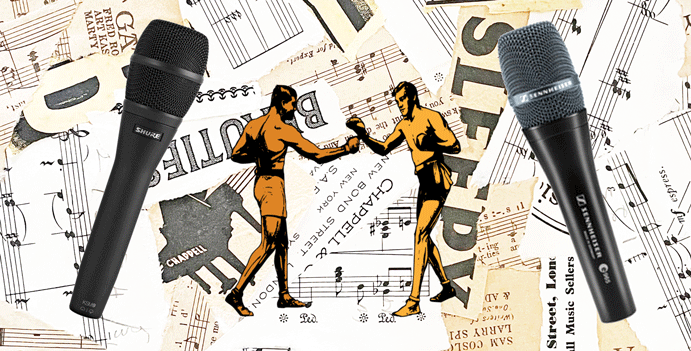
One of the closest competitors to the Sennheiser E965 is the Shure KSM9. They’re both handheld condenser mics optimised for live performance
Both the KSM9 and E965 have in common:
- Switchable cardioid and super-cardioid patterns
- Similarly smooth frequency responses
- A gentle roll-off at the low end
- A subtle boost in the high end
They even look similar, with tapered handles and squareish divided metal grilles. But there are some differences.
| Sennhesier E965 | Shure KSM9 | |
| Polar pattern | Cardioid & super cardioid | Cardioid & super cardioid |
| Frequency | 40Hz to 20KHz | 50Hz to 20kHz |
| Attenuation | Attenuation Switch (-10db) | No attenuation switch |
| Pop filter | Integrated | Integrated |
| Weight | 396 grams (14 oz) | 300 grams (10 oz) |
| Target price | Under $400 | Under $500 |
The KSM9 doesn’t have those handy extra features of the E965 – the attenuation switch and the low cut filter .
The Sennheiser also has a slightly larger diaphragm than the Shure. Large diaphragm mics tend to be better at capturing low-end, whereas smaller diaphragm microphones do a better job with higher frequencies and transient detail.
Another advantage of mics with a smaller diaphragm is that they have a more controlled, consistent pickup pattern.
Ultimately the Shure KSM9 and Sennheiser E965 are two similar microphones. I’d say the Shure is a little brighter in character, whereas the Sennheiser is a bit more pronounced in the lower-mids.
Holding the Sennheiser E965
Where you hold the microphone in relation to your mouth can make a big difference in sound. Professional vocalists are always repositioning their mics to change the tone and add expression to their performance.
Always hold the vocal mic by the main body, and if there’s too much sibilance, try holding it slightly to the side.
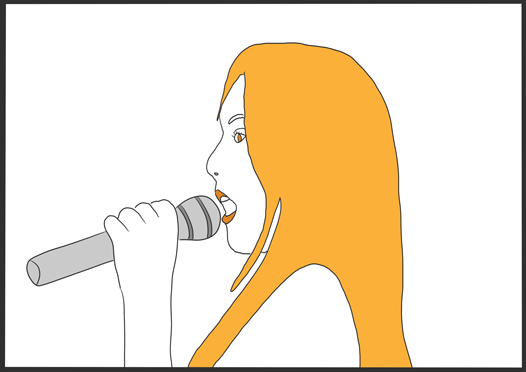
When you have other instruments in close proximity and you just want the sound of the voice, it’s best to sing or speak directly into the mic. This will add more bass to the sound, due to the ‘proximity effect’. It’s an effect used by radio presenters to give them very deep voices.
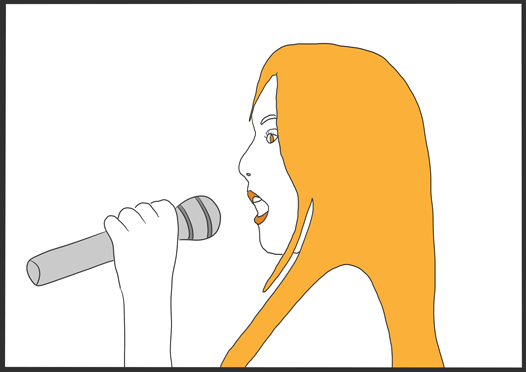
For a more natural, balanced sound, hold the mic between 5 and 10 cm away from your mouth. There’ll be less of the proximity effect, and the mic will pick up more sounds from other instruments, and the acoustics of the room.
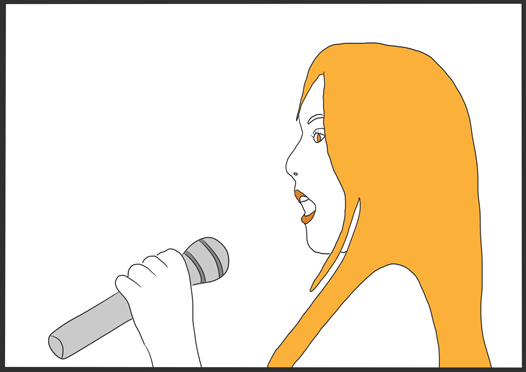
To bring in more of the room sound, and the instruments around you, hold the mic 10 cm or more away from your mouth. This is also a good position for any sudden loud notes, or to shape, and tail off a long note.
What else do you need?
With any vocal microphone, you’ll need:
- Microphone stand
Mic stands reduce any handling noise in the studio. Try a good quality boom stand, with a tripod base like the K&M 210/2
- XLR cable
If you want the best quality XLR cables, try these. Go for the shorter lengths where possible.
- Pop shield
This is to stop little bursts of air causing bassy pops on your studio recordings. You can easily make one of these out of stockings, or buy one here.
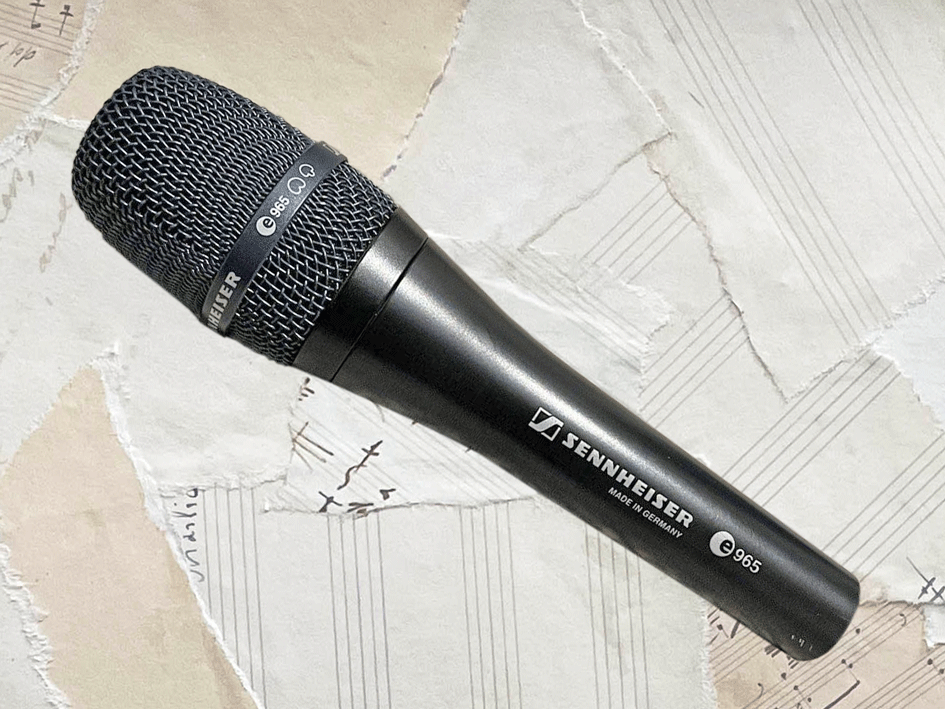
Conclusion
If you’re serious about your sound on stage and you want a mic that can give you studio quality and survive life on the road, this mic is for you.
Maybe you’ve had a cheaper mic for a while and you’re turning professional, or you want to really maximise the quality of your sound.
The flexibility of the Sennheiser E965 makes it an investment in your music making, whether you’re on stage or in your home studio. It’s not the cheapest out there, but neither should it be – the quality speaks for itself.
Sennheiser E965 Frequently Asked Questions
Does the Sennheiser E965 need phantom power?
The Sennheiser E965 is a condenser microphone, so it does require phantom power.
Can you use condenser mics on stage?
Condenser mics are a great choice for stage use as long as they have been designed specifically for live use. They’ll deliver a higher quality sound than dynamic mics.
Which artists use the Sennheiser E965?
Artists seen using the Sennheiser E965 include Lauren Mayberry, and Dan Smith.
Read the guide – best live vocal mics
| Review model | Type | Polar pattern |
| Sennheiser E835 | Dynamic | Cardioid |
| Sennheiser E845 | Dynamic | Super-cardioid |
| Sennheiser E935 | Dynamic | Cardioid |
| Sennheiser E945 | Dynamic | Super-cardioid |
| Shure SM58 | Dynamic | Cardioid |
| Shure Beta 58A | Dynamic | Super-cardioid |
| Telefunken M80 | Dynamic | Super-cardioid |
| Shure KSM9 | Condenser | Cardioid & super-cardioid |
